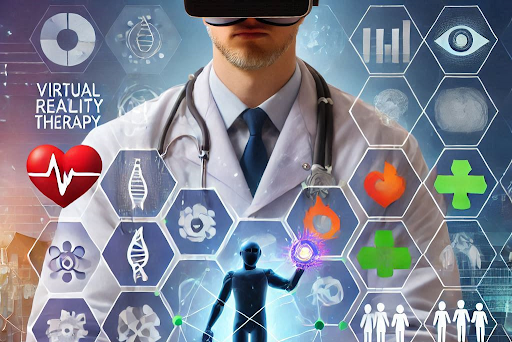Tremendous breakthroughs lately have emerged at the intersection of mental healthcare and technology. Of these, Virtual Reality stands out as the leading transformative tool that promises a thoroughly immersive and engaging experience towards an integration with therapeutic technique. Gamified VR therapy, in particular, shall prove to be a game-changer in treating anxiety disorders, PTSD, and phobias.
It is through these VR applications that the potential for better, easier, and more engaging treatments is opened up by marrying game elements with evidence-based mental health therapies.
The hope for gamified VR therapy
The gamification through inherent appeal uses the interactivity, the sense of achievement, and reward system of games and therefore guarantees user engagement and adherence in treatments. In a gamified approach, a typical VR treatment turns into a fun adventure, making it an enjoyable thing for patients. The old ways often failed to keep patient interest for treatments; normally, this usually leads to poor attendance or very irregular attendance.
For instance, an anxious person may find it very difficult to face their triggers in the real world. A gamified VR environment can simulate those triggers in a controlled and customizable setting and expose users to anxiety-inducing situations gradually in a manner that feels manageable and empowering. The gamified element adds layers of motivation through rewards, tracking of progress, and achievements, making the user want to stay on their therapy and own their progress. Reducing anxiety levels through VR gameplay
Anxiety disorders affect millions of people worldwide and result in significant impairment in day-to-day functioning. Traditional therapies, such as cognitive-behavioral therapy, have techniques like exposure therapy, where the patient is exposed to the feared stimuli under controlled conditions. This application of virtual reality takes this therapy to a higher plane by providing real-life experience in a virtual environment, with a heightened degree of control and customization.
For instance, a social anxiety VR therapy application could place a user in a virtual public speaking scenario. In such a setting, game mechanics could range from earning points for having eye contact or delivering speech without hesitation. These make the therapy interactive and quantifiable with measurable progress that boosts their confidence and reinforces positive behavior. They then tend to become better equipped to respond in such scenarios in the real world with their increasing levels of difficulties.
Combating PTSD through Immersive Experience Another area where gamified VR therapy holds immense promise is in the treatment of post-traumatic stress disorder. Exposure therapy for PTSD, traditionally a difficult task in which patients have to revisit traumatic memories to process and overcome them, can be achieved more safely under controlled conditions through VR exposure. A gamified application of VR with PTSD might involve a narrative game where patients are gradually exposed, in a safe environment controlled by the software, to elements of their traumatic experiences. So, a veteran suffering from combat-related PTSD would, through the simulation provided by the VR, have recreated the sounds of the battle for him.
These game elements of completing missions or solving puzzles will give a sense of purpose and accomplishment in engaging the therapy process, which in turn will help in lessening the fear and vulnerability felt.
Overcoming Phobias with Virtual Worlds
Another condition well-suited for VR-based interventions is phobias, which are intense and irrational fears of specific objects or situations. Exposure therapy is the gold standard for treating phobias, but it’s often difficult to implement in real-world settings because of logistical challenges and patient resistance. VR solves both problems by offering a virtual environment in which exposure can be carefully managed.
Imagine a VR game for someone afraid of heights.
Starting from the very simple task of crossing a low virtual bridge and culminating in standing on the edge of a skyscraper that may be complex, this is never scaring but always quite rewarding because there are reward-generating elements in gamification such as earning badges when particular tasks are completed, then unlocking new levels.
Users develop resilience and reduce anxiety by facing their fears in a virtual environment, which they experience when they face similar situations in real life.
The Role of VR Game Development Companies
Of course, the expertise and innovative power that comes with firms specializing in creating the most interesting experiences around games which can balance serious gaming with therapeutic aspects makes gamified VR therapy succeed. Hence, combining these firms’ work together with mental health professionals ensures that the applications are evidence-based practice while still entertaining in which the core value plays its role as an assurance for user involvement. The best VR game development companies set new boundaries to what can be possible with therapeutic gaming. They apply the most modern technologies, like eye-tracking, haptic feedback, and AI-driven adaptive systems, to provide experience tailored to specific needs. For example, in a VR therapy app, eye-tracking might determine the levels of engagement, which could increase or decrease difficulty levels according to it. Another great example would be simulating physical sensations through haptic feedback to increase immersion to enhance the effect on therapy even more.
Recruiting VR developers for Invented Solutions
Investors and companies venturing into the gamified VR therapy market need the services of professional virtual reality developers. They will provide technical know-how in designing, developing, and optimizing VR applications tailored to the specific needs of mental health therapy. From creating realistic environments to implementing complex gameplay mechanics, VR developers are crucial in bringing therapeutic visions to life.
When you hire virtual reality developers, it’s important for individuals or teams to have experience working with virtual applications, whether in gaming or for therapeutic purposes. This group ought to have proper expertise of VR technologies using either Unity or Unreal Engine. People need to know and design the application having strong exposure to user experience designs as well. Furthermore, cooperation also needs mental health experts ensuring that therapeutic applications would bring ethical as well as successful treatment procedures.
Business Potential of Gamified VR Therapy
For investors, gamified VR therapy is a very promising and impactful opportunity. The global mental health market will be quite large in the near future and will be fueled by growing awareness of mental health issues and increasing demand for innovative treatment options. With their potential to offer scalable and cost-effective therapy, VR applications are going to take up a considerable part of this market. Beyond the revenue opportunities, gamified VR therapy opens the door to meaningful changes in the lives of people. Investors into VR development for mental health can contribute toward an imminent future where the effective treatment is also an engaging experience for all. That duality of return and impact places gamified VR therapy high on the wish lists of forward-thinking investors.
Future Road: Collaboration and Innovation
The future of gamified VR therapy depends on developers, mental health professionals, and investors collaborating with one another. When the three key stakeholders come together, they can develop applications that will merge state-of-the-art technology with tried-and-tested therapeutic approaches. Innovation areas such as AI-based personalization, integration with biofeedback, and extensions through AR will also unlock more potential in VR therapy. Investors can play a vital role in funding research and development efforts, supporting startups and established VR gaming companies that are developing and fostering a relationship between the technology industry and the healthcare sector, focusing on projects that adopt an evidence-based approach for engagement. This is more than an innovation in new technology. It is a revolution in delivering mental care. This will offer an effective method of treatment for anxiety disorders, PTSD, or phobias by incorporating the motivating elements of play within the immersive power of virtual reality. This is good for those who want to get in on this emerging arena because it offers a healthier and tougher society both financially and ethically.
















Leave a Reply